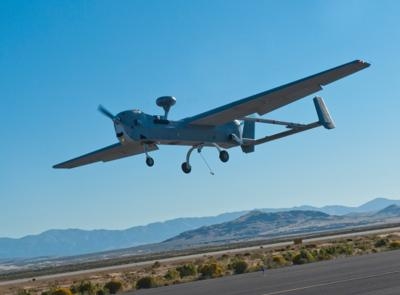Wed, Jan 15, 2014
U.S. Army Has Flown The Aircraft Since 1996
Northrop Grumman Corporation's Hunter Unmanned Aircraft System (UAS), in use with the U.S. Army since 1996, recently surpassed 100,000 combat flight hours in service. The MQ-5B Hunter, which is currently deployed supporting contingency operations across the globe, provides warfighters with state-of-the-art reconnaissance, surveillance, target acquisition (RSTA), communications relay and weapons delivery.

"Our very close working relationship with our Army customer has been critical to the program's enduring success," said Steve Hogan , vice president and general manager, Integrated Logistics and Modernization division, Northrop Grumman Technical Services. "The team's innovative partnering approach has been seamless over the years. The team has established an impeccable track record of continuous modernization and highly reliable performance while serving on the front lines shoulder-to-shoulder with our nation's warfighters in combat operations."
The RQ-5A Hunter was the Army's first fielded UAS. The MQ-5B is the next-generation Hunter, continuing a legacy of service to Army corps, division and brigade warfighters. Flying over the battlefield with its multimission optronic payload, the MQ-5B gathers RSTA information in real time and relays it via video link to commanders and soldiers on the ground.
The MQ-5B Hunter is distinguished by its heavy fuel engines, its "wet" (fuel-carrying) extended center wing with weapons-capable hard points and a modern avionics suite. The MQ-5B Hunter system uses the Army's One System ground control station and remote video terminal. It also carries a communications relay package to extend the radio range of warfighters. Hunter is also equipped with a differential GPS automatic takeoff and landing system. "This significant milestone is a credit to the sustained exceptional high levels of performance and technical expertise, dedication, professionalism and pride of all of our Northrop Grumman engineers, maintainers and operators," said Rob Sova , Hunter program manager, Northrop Grumman Technical Services. "This team lives and breathes our customer's mission and strives to exceed customer expectations every single day."
The MQ-5B features a robust, fixed-wing, twin tail-boom design with redundant control systems powered by two heavy fuel engines – one engine to "push" and another to "pull" the aircraft. Another Hunter capability is its relay mode that allows one Hunter to be controlled by another UAV at extended ranges or over terrain obstacles typical of those found in the Balkans and Afghanistan.
(Image provided by Northrop Grumman)
More News
From 2023 (YouTube Edition): "Ain’t Your Daddy’s Super Cub”—Don Wade Co-owned by Don and Ron Wade—the former of Don’s Dream Machines, a storied >[...]
Pilot-Rated Passenger Reported That The Pilot Did Not Adequately “Round Out” The Landing Flare And The Airplane Bounced And Yawed To The Right Analysis: The pilot state>[...]
Dead Reckoning Dead reckoning, as applied to flying, is the navigation of an airplane solely by means of computations based on airspeed, course, heading, wind direction, and speed,>[...]
Aero Linx: Lake Amphibian Club This website is created and sponsored by the Lake Amphibian Club, to help spread the word about these wonderful, versatile amphibians that can land j>[...]
“I am deeply honored to be sworn in as NASA administrator. NASA’s mission is as imperative and urgent as ever — to push the boundaries of human exploration, ignit>[...]
 Classic Aero-TV: In Praise of Alabamas Patriot Aircraft USA
Classic Aero-TV: In Praise of Alabamas Patriot Aircraft USA NTSB Final Report: Cirrus Design Corp SR22
NTSB Final Report: Cirrus Design Corp SR22 ANN's Daily Aero-Term (12.21.25): Dead Reckoning
ANN's Daily Aero-Term (12.21.25): Dead Reckoning ANN's Daily Aero-Linx (12.21.25)
ANN's Daily Aero-Linx (12.21.25) Aero-News: Quote of the Day (12.21.25)
Aero-News: Quote of the Day (12.21.25)



